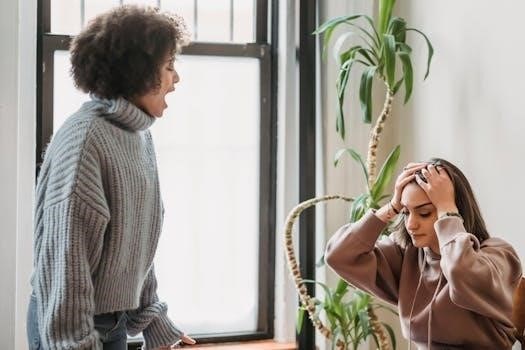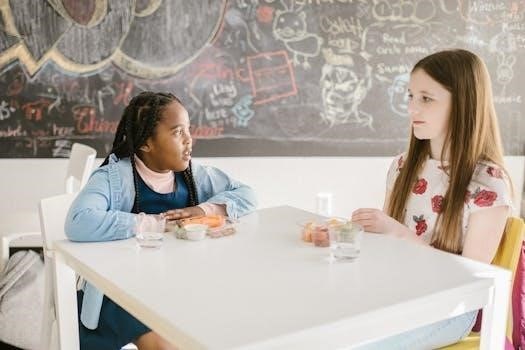Effective communication is a critical skill‚ impacting personal and professional success. Mastering it opens doors to stronger relationships and career advancements. This guide explores key techniques to enhance your ability to connect with anyone.
The Importance of Communication Skills
Communication skills are fundamental to human interaction‚ influencing how we build relationships‚ navigate social situations‚ and achieve our goals. Effective communication allows us to express ourselves clearly‚ understand others’ perspectives‚ and foster meaningful connections. In the workplace‚ strong communication skills are essential for collaboration‚ leadership‚ and career advancement. They enable us to network effectively‚ present ideas persuasively‚ and resolve conflicts constructively. Furthermore‚ the ability to talk to anyone‚ regardless of background or circumstance‚ can significantly enrich our lives‚ leading to new friendships‚ romantic partnerships‚ and opportunities. Mastering these skills can empower us to be more confident and socially successful‚ improving our overall well-being.
Key Techniques from “How to Talk to Anyone”
Leil Lowndes’ book provides 92 techniques for social success. These include strategies for first meetings and sophisticated communication‚ empowering individuals to connect with anyone.
The Flooding Smile Technique
The flooding smile technique‚ as described by Leil Lowndes‚ involves delaying your smile upon meeting someone. Instead of flashing an immediate grin‚ pause briefly‚ allowing your eyes to connect with theirs‚ and then let a warm‚ genuine smile spread across your face. This technique ensures that your smile feels more authentic and less like a reflex‚ making the recipient feel like they are the sole beneficiary of your pleasant expression. This slight delay makes a significant impact‚ creating a more positive and memorable first impression‚ conveying genuine warmth and interest.
The Sticky Eyes Technique
The sticky eyes technique‚ another powerful tool from “How to Talk to Anyone‚” focuses on maintaining consistent eye contact. Imagine your eyes are glued to your conversation partner’s‚ as if held by sticky‚ warm taffy. Avoid breaking eye contact even after they’ve finished speaking‚ allowing a few moments of sustained gaze. This technique conveys deep interest and attentiveness‚ making the other person feel truly heard and valued. It’s a subtle yet impactful way to build rapport and demonstrate that you are fully engaged in the interaction‚ strengthening the connection.
Mirroring and Matching Communication Style
Mirroring and matching involves subtly imitating your communication partner’s expressions‚ body language‚ pace‚ and tone. This technique fosters a sense of comfort and rapport by creating a subconscious connection. For instance‚ if someone speaks slowly and calmly‚ adjust your pace to match. If they use a lot of hand gestures‚ subtly incorporate some of your own. This mirroring effect makes the other person feel more understood and comfortable‚ as it signals that you’re in sync with them. It’s a powerful tool for building trust and creating more harmonious interactions.
The Briefcase Technique
The briefcase technique involves doing a little research on the person or group you’ll be interacting with. This could mean reading their publications‚ checking their social media profiles‚ or even just learning about their interests. By gathering this information‚ you equip yourself with relevant talking points and show that you’ve taken a genuine interest in them. This technique allows you to sound like an “insider‚” fostering an immediate connection by demonstrating you’ve done your homework. It’s a great way to make conversations feel more meaningful and engaging‚ moving beyond basic small talk.

Verbal Communication Strategies
Mastering verbal communication involves using effective conversation starters‚ active listening‚ and sharing relevant stories. These techniques help create engaging and meaningful interactions.
Conversation Starters
Initiating conversations‚ especially with strangers‚ can feel daunting. However‚ having a clear plan helps. Start by smiling and making immediate eye contact‚ signaling your openness. Avoid generic questions; instead‚ try observing something specific about their surroundings or mentioning a shared experience. Asking about their day or weekend plans‚ or if they’ve read any interesting books or articles can also be effective. Keep it light and avoid intense topics initially. The goal is to start a comfortable exchange that encourages natural flow of conversation.
Active Listening Skills
Active listening is crucial for meaningful conversations; it’s more than just hearing words. It involves fully concentrating‚ understanding‚ and responding thoughtfully to what’s being said. Demonstrate engagement by maintaining eye contact and using non-verbal cues like nodding. Avoid interrupting; instead‚ let them finish their thoughts. Reflect back what you’ve heard by summarizing or paraphrasing their points. Ask clarifying questions to show your interest and ensure mutual understanding. Active listening builds trust and rapport‚ transforming conversations into genuine connections.
Sharing Relevant Stories
Sharing relevant stories enhances conversations‚ making them more engaging and memorable. When sharing‚ aim for brevity and ensure the narrative aligns with the current topic. Avoid overpowering the conversation with lengthy personal anecdotes. Instead‚ try to match the tone and length of the other person’s stories. If they share a modest vacation tale‚ relate a similar experience of your own. Steer clear of one-upping or bragging‚ which can quickly derail the conversation. When done thoughtfully‚ sharing relevant stories creates a sense of shared experience and fosters deeper connections.

Non-Verbal Communication Strategies
Non-verbal cues are crucial for effective communication. Mastering eye contact‚ body language‚ posture‚ smiling‚ and nodding enhances your ability to connect and convey messages clearly.
The Power of Eye Contact
Eye contact is a potent tool in communication‚ signaling engagement and interest. Techniques like “sticky eyes‚” where you maintain eye contact even after someone has finished speaking‚ can create a deeper connection. However‚ it’s essential to avoid staring‚ which can be perceived as aggressive. Instead‚ aim for a comfortable‚ consistent gaze that shows you are truly present and listening. Effective eye contact fosters trust and rapport‚ making conversations more meaningful and impactful. It also demonstrates confidence and helps build stronger relationships by showing that you are paying attention to the other person.
Body Language and Posture
Your body language and posture speak volumes‚ often conveying more than words themselves. Open posture‚ such as relaxed shoulders and uncrossed arms‚ signals approachability and confidence. Conversely‚ closed-off stances can make you appear uninterested or defensive. Mirroring the other person’s posture subtly can build rapport‚ creating a sense of connection. Pay attention to your movements‚ ensuring they align with your message. Using gestures intentionally can emphasize points and make your communication more dynamic‚ enhancing engagement and understanding. Remember‚ mindful body language strengthens your message and fosters positive interactions.
Smiling and Nodding
Smiling and nodding are powerful non-verbal cues that significantly impact communication. A genuine smile can instantly make you appear more approachable and likable‚ fostering positive interactions. Nodding your head while someone is speaking demonstrates active listening and encourages them to continue‚ showing you are engaged and interested in what they have to say. However‚ it is important to use these cues authentically; forced smiles or excessive nodding can come across as insincere. Employ these techniques naturally to build rapport and create a more comfortable environment for open communication. When used effectively‚ smiling and nodding can transform how others perceive you.

Building Rapport and Connections
Building rapport involves creating a comfortable atmosphere. Using authentic compliments and making people feel good are key to forging deeper connections and more meaningful relationships.
Using Authentic Compliments
Offering genuine and specific compliments is a powerful way to build rapport. Instead of generic praise‚ focus on noticing and appreciating particular qualities or actions. This shows the other person that you are attentive and truly value them. A sincere compliment can make someone feel good‚ fostering a positive connection. When giving compliments‚ ensure they are appropriate for the context and avoid anything that could be misconstrued. The goal is to make them feel genuinely appreciated and comfortable‚ strengthening the bond between you.
Creating a Comfortable Atmosphere
Establishing a relaxed and comfortable environment is essential for effective communication. This can be achieved by being welcoming‚ approachable‚ and attentive to the other person’s needs. Start by using open body language‚ maintaining soft eye contact‚ and offering a genuine smile. Be mindful of your tone of voice‚ keeping it friendly and encouraging. It’s also vital to avoid any behaviors that might make the other person feel judged or uncomfortable. Focus on making them feel heard and valued‚ ensuring that they feel safe and at ease throughout the interaction. This will encourage open and honest dialogue.

Advanced Communication Skills
Moving beyond basic techniques‚ advanced skills involve adapting to various contexts and using techniques like the “Tombstone” to create lasting impressions and build powerful connections.
The Tombstone Technique
The Tombstone Technique‚ a concept from “How to Talk to Anyone‚” involves using specific‚ authentic compliments to build rapport and make a lasting positive impression. It is about crafting a memorable‚ positive statement‚ like an inscription on a tombstone‚ about the person you’re interacting with. This technique emphasizes the power of focused and genuine appreciation. The goal is to create a feeling of being truly seen and valued by offering unique observations that go beyond generic compliments. This method can strengthen connections and foster deeper relationships by showing you’ve paid close attention to the person and their attributes. It leaves a memorable positive impact.
Adapting to Different Contexts
Adapting your communication style to different contexts is crucial for effective interaction. Recognizing that a single approach won’t work in all situations is key. Factors like cultural background‚ professional setting‚ and personal relationship dynamics should influence how you communicate. Being mindful of the environment and tailoring your language‚ tone‚ and non-verbal cues accordingly demonstrates social intelligence. For instance‚ a casual conversation with a friend will differ greatly from a formal business meeting. Successful communicators can seamlessly adjust their methods to suit the specific demands of each interaction‚ ensuring their message is received positively and effectively. Flexibility is paramount.
Mastering communication techniques leads to stronger connections and greater social success. By practicing these skills‚ you can significantly improve your ability to talk to anyone.
The Benefits of Mastering Communication
Mastering communication offers significant advantages‚ enhancing your ability to connect with others and build strong relationships. Effective communication opens doors to career advancement‚ allowing you to network‚ collaborate‚ and lead teams more successfully. It boosts your confidence and makes you more approachable‚ leading to deeper personal connections. These skills help you navigate various social situations with ease‚ from casual conversations to more complex interactions. Furthermore‚ clear and effective communication reduces misunderstandings and conflicts‚ fostering better collaboration and harmony in all areas of life. Ultimately‚ improving your communication skills empowers you to achieve greater success and fulfillment‚ both personally and professionally.
